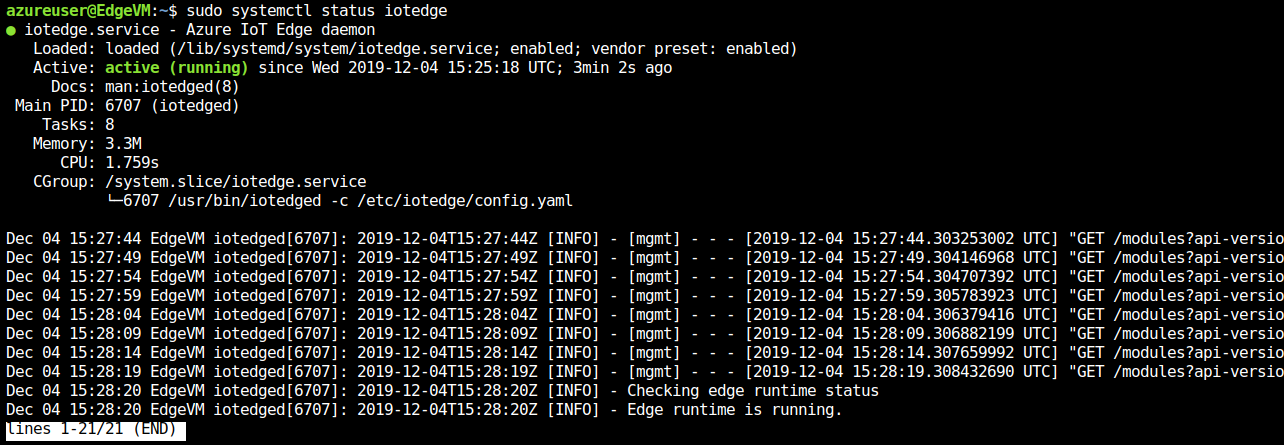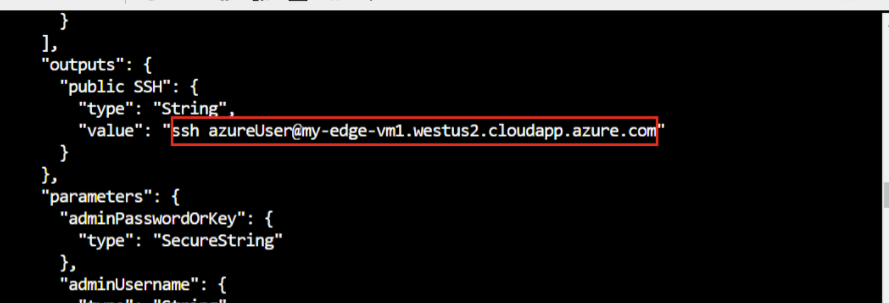Exercise - Set up communication between IoT Hub and IoT Edge
This exercise uses the Azure CLI in Azure Cloud Shell to run the required commands.
Install Azure IoT extension
Add the Azure IoT extension to the Cloud Shell instance Azure CLI.
az extension add --name azure-iot
Note
This article uses the newest version of the Azure IoT extension, called azure-iot. The legacy version is called azure-cli-iot-ext. You should only have one version installed at a time. To check which extensions are installed, run az extension list.
Run az extension remove --name azure-cli-iot-ext to remove the legacy version of the extension.
Run az extension add --name azure-iot to add the new version of the extension.
Create a resource group
Create a resource group named "IoTEdgeResources" by running the following command:
az group create --name IoTEdgeResources --location eastus2
The output is similar to the following:
Create an IoT hub
The following code creates a free F1 tier hub in the resource group "IoTEdgeResources." Replace {hub_name} with a unique name for your IoT hub.
az iot hub create --resource-group IoTEdgeResources --name {hub_name} --sku F1 --partition-count 2
Note
If you get an error because there's already one free hub in your subscription, change the SKU to S1. Each subscription can only have one free IoT hub. If you get an error that the IoT hub name isn't available, it means someone else already has a hub with that name.
Register an IoT Edge device
In Azure Cloud Shell, follow these steps to create a device named "myEdgeDevice" in your hub.
Create a device identity
IoT Edge devices behave and are managed differently than typical IoT devices. Use the --edge-enabled flag to declare this identity as an IoT Edge device.
Important
If you see an error about "iothubowner policy keys", ensure that your Cloud Shell is running the latest version of the azure-iot extension.
The following command creates the device identity:
az iot hub device-identity create --hub-name {hub_name} --device-id myEdgeDevice --edge-enabled
Retrieve the connection string
To retrieve the connection string for your device, which links your physical device with its identity in IoT Hub, use this command:
az iot hub device-identity connection-string show --device-id myEdgeDevice --hub-name {hub_name} --output table
The output is similar to the following:
HostName={YourIoTHubName}.azure-devices.net;DeviceId=MyNodeDevice;SharedAccessKey={YourSharedAccessKey}
Copy the value of the connectionString key from the JSON output and save it. This value is the device connection string, which is used to configure the IoT Edge runtime in the next section.
Deploy the IoT Edge device
Use this CLI command to create your IoT Edge device based on the prebuilt iotedge-vm-deploy template. Copy the command into a text editor, replace the placeholder text with your information, and then paste it into your bash or Cloud Shell window:
az deployment group create \
--resource-group IoTEdgeResources \
--template-uri "https://aka.ms/iotedge-vm-deploy" \
--parameters dnsLabelPrefix='<REPLACE_WITH_VM_NAME>' \
--parameters adminUsername='azureuser' \
--parameters deviceConnectionString=$(az iot hub device-identity connection-string show --device-id myEdgeDevice --hub-name
<REPLACE_WITH_HUB_NAME> -o tsv) \
--parameters authenticationType='password' \
--parameters adminPasswordOrKey="<REPLACE_WITH_PASSWORD>"
Ensure your password (adminPasswordOrKey) is at least 12 characters long and includes three of the following: lowercase characters, uppercase characters, digits, and special characters.
It might take a few minutes to create and start the new virtual machine. After the deployment is complete, you receive JSON-formatted output in the CLI containing the SSH information to connect to the virtual machine. Copy the value of the public SSH entry in the outputs section:
View the IoT Edge runtime status
Use this command to connect to your virtual machine. Replace azureuser if you used a different username during the VM deployment. Replace <DNS-name> with your machine's DNS name.
ssh <admin-username>@<DNS-name>
Check if the IoT Edge device is configured
To verify that the IoT Edge security daemon is running as a system service, use iotedge commands.
Important
You need elevated privileges to run iotedge commands.
Run the following command to check the status of the IoT Edge device:
sudo systemctl status iotedge
The resulting output should be similar to this:


Your IoT Edge device is now configured. It's ready to run cloud-deployed modules.
To troubleshoot the service, retrieve the service logs.
journalctl -u iotedge
View all the modules running on your IoT Edge device. Since the service just started for the first time, only the edgeAgent module is running. The edgeAgent module runs by default and helps to install and start any additional modules that you deploy to your device.
sudo iotedge list



